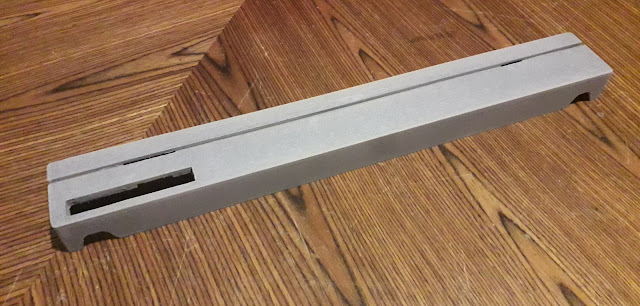That's a very rare Commodore 64 model... one could even say, unique!
Yes, I've been working on this desktop C64 case idea for a while. It is loosely modeled after the C128D cover. The front panel was a bit unsatisfying so I finally went and made something that is more in the spirit of the computer.
I'm making these from chipboards that are maybe more commonly used in building dolls houses. It's easy to cut and sturdy enough for these computer cases, if some thought is put into the structure.
I'm not too keen to do truly wooden cases, partly because I don't like the look and partly because I don't have the equipment and environment to do them properly.
I'll need to repeat that what I'm doing here might be a fire hazard, and the dust these chipboards produce could be a bit bad for the computer too. So consider these as prototypes.
Some work-in-progress snaps:
 |
| It fits! |
Gluing the three long pieces together was not the easiest task as they are not easy to support.
 |
| It can be removed! |
I wanted to paint the entire case, which would have looked nice enough without the panel, BUT when the cover is opened it would have left a visible seam/crack. With this "hat" I can model and paint the case in the future with less problems.
Next up was the slice in front, which was a precision job with the saw. I used a ruler to drag two traces with the saw, then they were properly cut. Another route might have been to make them as two pieces in the first place. I felt better with this approach.
Talking of routes I have a hand router somewhere but did not think to use it here.
 |
| The SD2IEC is at the left because it is nearer at my desk. |
I made a backpanel for the front panel (if that makes sense) so the cart is less visible than in the image above. It still bounces out but not as easily as I'd hope. I'll perhaps adjust the SD2IEC position a bit.
Also, the bolts at the bottom of the case were somewhat in the way of the "hat" so I had to do room for them. In hindsight, these could have been made through-holes, but maybe it would have been a bit too complicated.
This goes to show how earlier choices affect later ones, as I didn't plan on doing the hat at that stage. For purposes of design, it would make sense to rebuild the entire case now.
 |
| Making room for the bolts |
The Commodore 64 badge/nameplate was ordered via eBay from Poland.
By the way I used some wood putty to smooth the ends parts, because I glued them the smooth side inwards. I hoped the surfaces would stick better. This meant they had to be sanded and even then smoothed out with the putty.
 |
| Cutting the hole for the nameplate |
For example I left out the floppy drive opening although I considered it for a long while. The SD2IEC is in different position anyway and this is a Commodore 64 after all.
 |
| The grey primer spray |
The first layer of spray white already reveals problems in my approach. The front side is as I expected but the paint mercilessly reveals all blemishes, seams and inaccuracies in the corners and sides. I was also too eager to paint it in one go, whereas gentle layers would have worked better.
 |
| Needs sanding and more paint. |
The groove does not get enough paint really, but as it's not very visible I don't care too much.
The rounded corners are always challenging. If they don't succeed in one go they are a bit difficult to fix. All looked fine after doing the initial 45 degree bevel and smoothing it out, but subsequent sanding broke things a bit. I managed to fix it somewhat for the end result.
 |
| Ground paint and three layers of white spray. |
There's still work to be done, especially on the backside which I've been too embarrassed to show. I now feel the design of the case should begin with solving the backside rather than the front, but it's too tempting to go straight for the more interesting workstages.

Interesting. On first glance, I'd thought maybe you'd repurposed an old Macintosh LC case -- but a chipboard construction is a far more ambitious/creative undertaking. Plus, it can't be that much of a fire hazard, with the C64's external power supply.
ReplyDelete